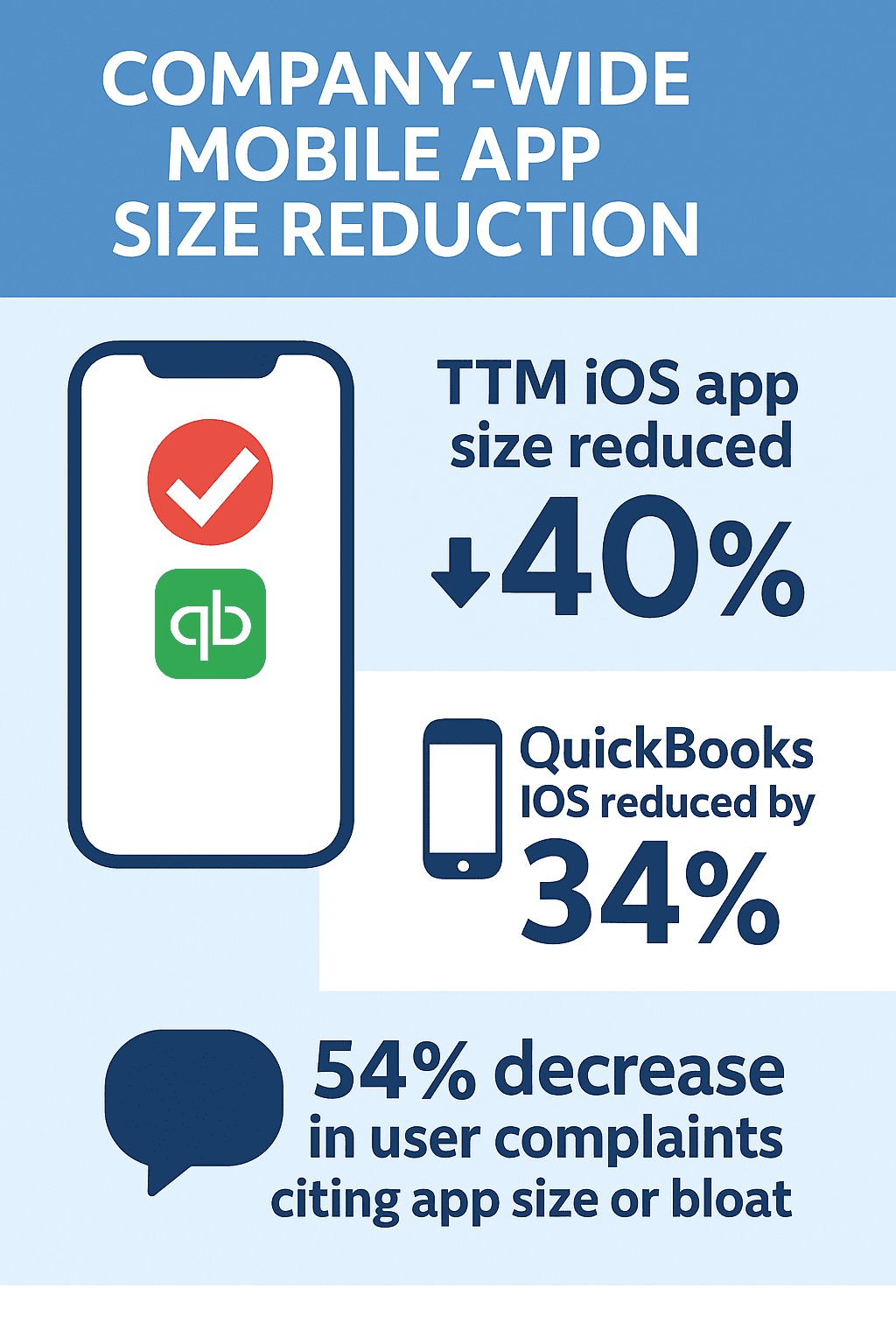From Bloat to Best-in-Class: Reimagining Mobile App Size at Scale
Impact:
- TTM iOS flagship app reduced from 319MB → 188MB (40%) with ~44% reduction on Android
- QB iOS app reduced from 702MB → 462MB (~34% reduction)
- ~54% drop in user reviews mentioning app size or bloat

Problem & Strategic Context
Our mobile apps had ballooned to 2–4x the size of peer benchmarks, creating friction across the user journey:
Slower downloads over mobile networks, particularly in bandwidth-constrained regions
Elevated uninstall rates tied to device storage constraints
Noticeable performance degradation (e.g., longer load times, lag on older devices), directly impacting engagement and retention KPIs
User interviews revealed direct pain points:
“I’m frustrated because I can’t download the app over cellular. I need Wi-Fi, which isn’t always available, so I look for alternatives.”
Industry benchmarks backed this:
Every 6MB increase in app size caused a 1% drop in install conversion.
20% of users uninstall apps due to storage concerns
Internally, size monitoring was fragmented. There were no shared thresholds, dashboards, or CI integrations. As a result, size regressions were common and often went unnoticed until late in the release cycle.


🔍 Root Cause Analysis
I partnered with platform and mobile teams to investigate why our app sizes had ballooned across the Intuit ecosystem. Through cross-app audits and tooling diagnostics, we identified four systemic issues:
✅ Unused Assets & Code: Legacy media, debug symbols, and obsolete modules lingered across builds, inflating size without adding value.
✅ Lack of Visibility: Teams lacked centralized dashboards or alerts for app size, so regressions often went unnoticed until late-stage QA or release reviews.
✅ Inconsistent Optimization Practices: No standard tooling existed across iOS/Android teams for compression, deduplication, or pruning—leading to uneven outcomes.
✅ Missing CI Integration: Size checks weren’t part of the dev workflow (PRs, release gates), making it easy for bloat to creep in over time.
These gaps made size inflation a silent killer—hurting install conversions and retention without ever raising red flags. Fixing this meant building systemic awareness, not just one-off cleanups.
🛠 Strategy & Execution
1. Audit & Prioritization
- Conducted baseline size audits.
- Prioritized apps based on install volume, size bloat, and optimization headroom
2. App Insights Platform
- Built and deployed developer tooling for size optimization within CI and dashboards.
3. CI/CD Enforcement
- Surfaced size diffs in every pull request with file-level granularity.
- Enabled custom thresholds (e.g., % of app size or KB per PR).
- Auto-blocked PRs that exceeded limits.
- Raised visibility through Slack alerts.
4. Reusable Playbooks
- Packaged optimization techniques into self-serve templates and scripts
- Enabled teams to fix regressions without deep platform knowledge

Outcome Metrics

💡 Key Learnings &
🎯 Why This Matters
This wasn’t just about shrinking binaries—it was about changing how we prioritize user-centric performance and engineering discipline at scale.
Most teams viewed app size as a downstream concern or “nice to have.” We flipped that mindset by embedding size tracking into the developer workflow. From PR checks to Slack alerts, insights were made visible where decisions happen—prompting real-time action, not retroactive clean-up.
By treating app size as a user acquisition and retention lever, we tied technical hygiene directly to business impact:
Faster downloads = higher install conversion, especially in low-connectivity regions.
Smaller footprint = fewer uninstalls, longer session lifespans.
Cleaner builds = better runtime performance and platform compliance.

Tooling drives behavior
Developers acted when insights were surfaced directly in PRs and IDEs (Xcode, Android Studio)

User-centric framing matters
By reframing app size reduction as a user acquisition and retention enabler—not just a tech debt fix—we galvanized engineering focus across product lines.

Scale through standardization
Shared tools and thresholds enabled broad adoption without duplicating effort.